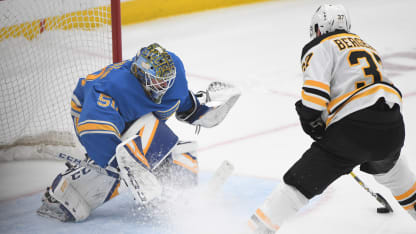For most, that means reviewing video provided by their goaltending coach before the games.
"I'll go one time through it on maybe their top five guys," said Demko, who has allowed two goals on 12 shootout attempts in his NHL career. "Right when I get to the rink it's on an iPad for me, so I'll just quickly go through it. It will [show] what their tendencies are and then give like five or six different examples of what they might try to do. It's good to have an idea but it's not something that you can really look too much into."
Sometimes, when a shooter's trend is clear and easy to recognize, preparation usually pays off.
But other times it can backfire.
Think of it in baseball terms. Hitters know a pitcher's best pitch and expect it in crucial situations. Same for goalies in the shootout. They know a shooter's go-to move and anticipating it increases the odds of success, but also the opportunity for spectacular failure if the shooter goes against his tendencies.
The work that goes into breaking down one-on-one trends and tactics has changed since the NHL introduced shootouts in 2005-06 to decide games tied after overtime.
Strategies were simpler when goalties only had to worry about breakaways, which are a different experience, because of the limited time and space a shooter has on a rush.
Back pressure from a defender on a breakaway makes it easier for goalies to try to match the speed of an oncoming shooter and time their retreat to arrive near the edge of the crease when the attacking player reaches the lower hash mark of the face-off circle. This allows the goalie to make sure he has enough backward momentum to get to the goal posts in case of a deke.
For many, the intention is to encourage the deke, which requires a left-or-right reaction from the goalie, compared to a shot, which has many more variables in direction and elevation for a goalie to counter.
In the shootout, the attacking player is not confined by time or space. He can go in any direction, except backward, and at any speed in his advance toward the net.
A goalie still wants to arrive at a specific spot relative to the top of their crease when a shooter hits the hash mark, but the shooter's ability to alter speed or route in the shootout, unlike a breakaway, places an increased emphasis on patience for the goalie.
Committing too soon is a problem, especially when a goalie is expecting one move in the shootout and the shooter delivers another. This is further complicated because many shooters use the same path to the net to set up a variety of finishing moves.
"A lot of guys have different routes for different moves, but players get smarter and smarter and nowadays a lot take the same route every time and do different moves," said Blues backup Jake Allen. "As a goalie, you think he's going to do this, but they do another move."
For that reason, Allen has also ditched the iPad that was a staple of preparation for his former St. Louis teammate Elliott, who is now with Philadelphia Flyers.

